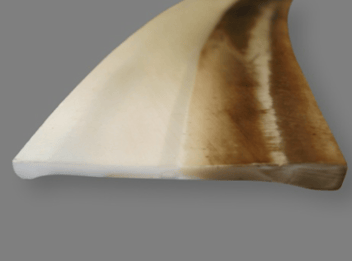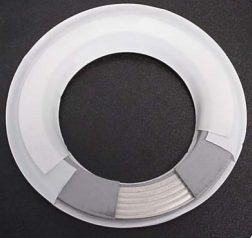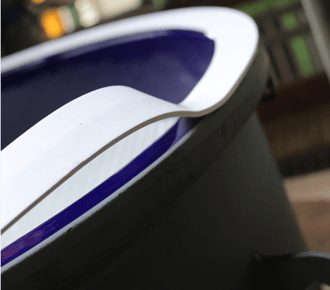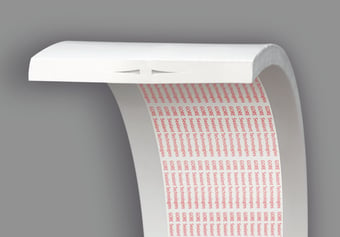PTFE Gasket Options for Glass-Lined Steel Equipment
 The role of a gasket is to create a tight seal between two components to prevent the unwanted emission of liquid or gas. Depending on the equipment in which they are installed, gaskets sometimes require a higher level of resistance to pressure and temperature due to operating specifications. Since compression is required to maintain the seal, gaskets are often made with a malleable material, such as PTFE (polytetrafluoroethylene). A PTFE gasket is able to more effectively create a seal between the harder surfaces of the components it is placed between when than a gasket made from rigid material, such as stainless steel.
The role of a gasket is to create a tight seal between two components to prevent the unwanted emission of liquid or gas. Depending on the equipment in which they are installed, gaskets sometimes require a higher level of resistance to pressure and temperature due to operating specifications. Since compression is required to maintain the seal, gaskets are often made with a malleable material, such as PTFE (polytetrafluoroethylene). A PTFE gasket is able to more effectively create a seal between the harder surfaces of the components it is placed between when than a gasket made from rigid material, such as stainless steel.
PTFE is the most commonly used fluoropolymer for gasket construction. Its inertness and superior chemical resistance make it a choice material throughout a variety of industries including medical, scientific, electronic, food and beverage, as well as a range of industrial applications. The rigorous operating conditions of glass-lined equipment make PTFE an ideal gasket selection due to its chemical properties, low coefficient of friction, and outstanding temperature resistance.
Glass-Lined-Steel Sealing Challenges
We’ve talked a lot in previous posts about the benefits of glass-lined steel (for those of you that aren’t familiar with this type of equipment can read our post entitled 5 Reasons your Process Could Benefit from Glass-Lined Steel Equipment or download our Introduction to Glass-Lined Steel Equipment eGuide). The composition and properties of glass-lined steel make it a desirable material of construction for processes that involve aggressive media that operate under rigorous conditions. These same harsh demands on this equipment can make it challenging to maintain a tight, lasting seal primarily due to limitations on gasket loads and fluctuations in the sealing surfaces. And these sealing challenges increase as flanged connections get larger in diameter. That is why it is important to make sure you are using the proper gasket for a given application. Failing to do so can lead to premature gasket failure, with consequences that range from problematic to catastrophic, including:
- Leakage/emissions
- Equipment damage
- Production downtime
- Risks to personnel safety
Sealing Solutions
There are a number of different gasket solutions. Depending on the size of the flange and service conditions of the equipment, there might be a solution that is more effective for one scenario than another. In this post we’ll review the different types of PTFE gaskets available and their utilization.
Unfilled PTFE Gaskets
Gaskets made of 100% PTFE are referred to as unfilled PTFE. Unfilled PTFE gaskets are quite versatile and can be used in most general applications. Within this category are two classifications: Virgin grade PTFE is a soft, formable material that is made directly from the resin producer, giving it the highest physical properties and resistance to creep (the frequently used term that refers to compression under load). Mechanical grade PTFE is still 100% PTFE but it is made from reprocessed resin so it’s not suited for high-purity or food applications. Typically virgin grade can be recognized by its whiter color when compared with mechanical grade. Different design options are also available, including:
- Single Envelope Gaskets: Designed for both small and larger nozzles, the virgin PTFE slit envelope is constructed of formed tape with a smooth, butt-welded junction (especially important for high-vacuum service). This envelope is used to protect the compressible inserts from the process environment. There are a lot of different envelope gaskets available, so it is important to make sure you are purchasing one that is appropriate to use with glass-lined equipment.
 Double Envelope Gaskets: This is similar to the single-envelope, except that a second envelope is used to “enclose” the entire gasket. The inner envelope protects the process side while the outer envelope protects from any atmospheric contaminants. A virgin PTFE slit type or butt-welded type envelopes are used to fully encapsulate the gasket from both the process side and the atmospheric side of the joint. Again, it is critical to ensure you are using a design suitable for glass-lined equipment.
Double Envelope Gaskets: This is similar to the single-envelope, except that a second envelope is used to “enclose” the entire gasket. The inner envelope protects the process side while the outer envelope protects from any atmospheric contaminants. A virgin PTFE slit type or butt-welded type envelopes are used to fully encapsulate the gasket from both the process side and the atmospheric side of the joint. Again, it is critical to ensure you are using a design suitable for glass-lined equipment.
- U-cut Gaskets: A multi-purpose U-channel gasket is an exceptionally high quality gasket for normal service applications on all glass-lined and alloy process equipment where PTFE is compatible with the product and process operating conditions. Instead of a butt-welded envelope, this design incorporates an envelope that is machined from a solid piece of PTFE, eliminating the need for any welds in the fabrication. The U-cut design combines a unique convex geometry to allow the gasket to conform more uniformly to the compressive forces when the nozzle bolts are torqued, making it highly attractive for food and pharmaceutical applications where product build-up is not acceptable and CIP is required.
Filled PTFE Gaskets
Filled PTFE gaskets include additives whose material helps to expand the performance of the gasket, enhancing its physical and chemical properties. Due to the improved mechanical strength over virgin PTFE, filled PTFE gaskets are the most widely used for industrial applications. The three main types of filler that are used in this style are:
- Carbon: Ranging in amount from approximately 10-35%, carbon filler increases compressive strength and can improve conductivity while still providing good chemical resistance. Carbon additives also help to increase the hardness and can improve the wear properties of the gasket.
- Graphite: Beneficial in hydraulic/pneumatic compression type seals and rotary applications, the addition of graphite to a gasket (approximately 5-15%) reduces the coefficient of friction and increases strength when compared to unfilled PTFE models.
- Glass: The addition of fiberglass in increments of 5-40% effectively increases the compressive strength of the gasket, increasing wear and reducing creep. This type of gasket is useful in applications that require a reduction in cold flow. The addition of glass doesn’t negatively affect the chemical and electrical properties of virgin PTFE. Protection rings that are used on larger manway openings are usually made of glass-filled PTFE.
ePTFE Tape
 Expanded PTFE is created by rapidly stretching PTFE under the right conditions to create a very strong, microporous material. The resulting material, known ePTFE, exhibits the amazing array of properties found in virgin PTFE, including:
Expanded PTFE is created by rapidly stretching PTFE under the right conditions to create a very strong, microporous material. The resulting material, known ePTFE, exhibits the amazing array of properties found in virgin PTFE, including:
- Strength (high strength-to-weight ratio)
- Chemical inertness
- Biocompatibility
- High thermal resistance
- High chemical resistance in harsh environments
- Low flammability
- Low coefficient of friction
- Low dielectric constant
- Low water adsorption
- Good weathering properties
Expanded PTFE is much softer and more flexible than regular PTFE, giving it the ability to be manufactured into tape that can be fitted and installed onto a flange with an end product similar to how a traditional gasket would function. The added benefits of ePTFE tape are ease of compression, minimal creep and cold flow, and the ability for on-site customization (which eliminates the long lead times and complicated logistics that are brought about by offsite shipping, handling and installation).
GORE Gasket Tape Series 1000
 Designed specifically for the challenges of glass-lined steel, GORE Gasket Tape Series 1000 addresses the issue of reliably sealing large glass-lined-steel flanges. Made of 100% ePTFE, this highly conformable tape is chemically inert, and highly resistant to creep, cold flow and clamp-force loss. It features a proprietary barrier core maintains an extra tight seal even at low loads, sealing more than 10 times tighter than other ePTFE gasket tapes.
Designed specifically for the challenges of glass-lined steel, GORE Gasket Tape Series 1000 addresses the issue of reliably sealing large glass-lined-steel flanges. Made of 100% ePTFE, this highly conformable tape is chemically inert, and highly resistant to creep, cold flow and clamp-force loss. It features a proprietary barrier core maintains an extra tight seal even at low loads, sealing more than 10 times tighter than other ePTFE gasket tapes.
GORE Gasket Tape Series 1000 is designed for use in larger (>24”) or non-standard flanges typically found in columns, mixer vessels, reactors, storage and receiver tanks. For more information about this product and how it works visit our GORE Gasket Tape Series 1000 webpage or check out Gore's website for additional insight on their ePTFE technology.
PTFE’s unique properties and unmatched versatility make it a popular choice of gasket construction in many industrial applications, particularly in chemical processes that involve aggressive media and require high-purity conditions. Unfilled PTFE, filled PTFE, and ePTFE tape are all excellent choices and offer distinctive advantages based on different process conditions. Factors such as flange size and operating pressure and temperature will help to determine which type will perform the best for you. If you have questions or need assistance pertaining to sealing issues specific to your glass-lined steel equipment, please contact the DDPS Aftermarket Department at 908-317-2585 or submit a form online and we will get back to you with more information concerning your inquiry.
Want to find out more about how easy it is to install ePTFE tape? Download the installation instructions for Gore Gasket Tape Series 1000 to see for yourself:
